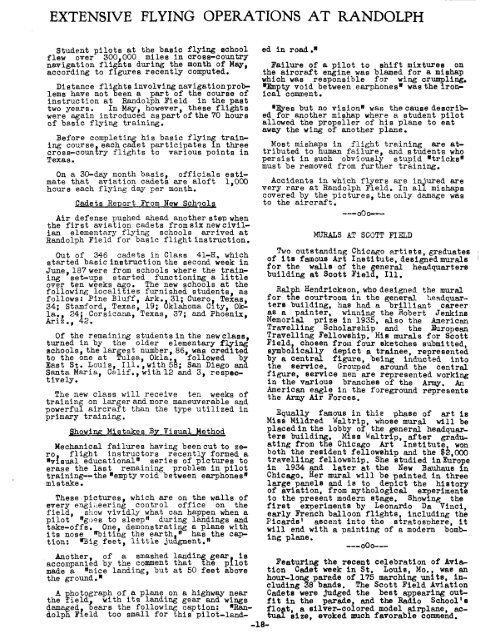News Letter 1941 Jul-Dec - Air Force Historical Studies Office
News Letter 1941 Jul-Dec - Air Force Historical Studies Office
News Letter 1941 Jul-Dec - Air Force Historical Studies Office
Create successful ePaper yourself
Turn your PDF publications into a flip-book with our unique Google optimized e-Paper software.
EXTENSIVE FLYING OPERATIONS<br />
AT RANDOLPH<br />
Student pilots at the basic flying school<br />
flew over 300 000 miles in cross-country<br />
navigation fligtts during the month of M~,<br />
according to figures recently computed.<br />
Distance flights involving navigationproblems<br />
have not been a part of the course of<br />
instruction at Randolph Field in the past<br />
two years. In M~, however, these flights<br />
were again introduced as part of the 70 hours<br />
of basic flying training.<br />
Before completing his basic flying training<br />
course each cadet participates in three<br />
cross-country flights to various points in<br />
Texas.<br />
On a 3D-day month basis, officials estimate<br />
that aviation cadets are aloft 1,000<br />
hours each flying day per month.<br />
Cadets Report From New SCh001s<br />
<strong>Air</strong> defense pushed ahead another step when<br />
the first aviation cadets from six new civilian<br />
elementary flying schools arrived at<br />
Randolph Field for basic flight instruction.<br />
Out of 346 cadets in Cla~s 4l-H, which<br />
started basic instruction the second week in<br />
June, 187 were from schools where the training<br />
set-ups started functioning a little<br />
over ten weeks ago. The new schools at the<br />
following localities furnished students, as<br />
follows: Pine Bluff, Ark.} 31; Cuero, Texas,<br />
34; Stamford, Texas, 19; uklahoma Clty, Okla.,<br />
24, Corsicana, Texas, 37; and Phoenix,<br />
Ariz., 42.<br />
Of the remaining students in the new class,<br />
turned in by the older elementary flying<br />
schools, the larges t number, 86, was credi ted<br />
to the one at Tulsa, Okla. followed by<br />
East St. Louis, Ill.,with 5~; San Diego and<br />
Santa Maria, Calif., wi th 12 and 3, respectively.<br />
The new class will receive ten weeks of<br />
training on larger and more maneuverable and<br />
powerful aircraft than the type utilized in<br />
primary training.<br />
Showing Mistakes By Visual Method<br />
Mechanical failures having been cut to zero,<br />
flight instructors recently formed a<br />
.vlsual educational" series of pictures to<br />
erase the last remaining problem in pilot<br />
training-the lIemptyvoid between earphonesll<br />
mistake.<br />
These pictures, which are on the walls of<br />
every engLceering control office on the<br />
field, show vividly what can happen when a<br />
pilot "gl)es to sleep" during landings and<br />
take-offs. One, demonstrating a plane with<br />
its nose "biting the earth." has the capo.<br />
tion: lI:J3ig feet, 11ttle jua.gment."<br />
Another, of a smashed landing gear is<br />
accompanied by the comment that the pIlot<br />
made a "nice landing, but at 50 feet above<br />
the ground. 1I<br />
ed in road.1I<br />
Failure of a pilot to shift mixtures on<br />
the aircraft engine was blamed for a mishap<br />
which was responsible for wing crumpling.<br />
"Empty void between earphones ll was the ironical<br />
comment.<br />
IIEyesbut no vision" was the cause described<br />
for another mishap where a student pilot<br />
allowed the propeller of his plane to eat<br />
away the wing of another plane.<br />
Most mishaps in flight training are attributed<br />
to human failure, and students who<br />
persist in such obviously stupid IItricks"<br />
must be removed from further training.<br />
Accidents in which flyers are injured are<br />
very rare at Randolph Field. In all mishaps<br />
covered by the pictures, the only damage was<br />
to the aircraft.<br />
---000---<br />
MURALS AT SCOTT FIELD<br />
Two outstanding Chicago artists, greduates I<br />
of its famous Art Institute, designed murals<br />
for the walls of the general headquarters<br />
building at Scott Field, Ill.<br />
Ralph Hendrickson, who designed the mural<br />
for the courtroom in the general headquar .•<br />
ters building, has had a brilliant career<br />
as a painter, winning the Robert Jenkins<br />
Memorial prize in 1935, also the American<br />
Travelling Scholarship and the European<br />
Travelling Fellowship. His murals for Scott<br />
Field, chosen from four sketches s1lbmitted,<br />
symbolically depict a trainee, represented<br />
by a central figure, being inducted into<br />
the service. Grouped around the central<br />
figure, service men- are represented working<br />
in the various branches of the Army. An<br />
American eagle in the foreground represents<br />
the Army <strong>Air</strong> <strong>Force</strong>s.<br />
Equally famous in this phase of art is<br />
Miss Mildred Waltrip, whose mural will be<br />
placed in the lobby of the general headquarters<br />
building. Miss Waltrip, after gradu.-<br />
ating from the Chicago Art Institute, won<br />
both the resident fellowship and the $2,000<br />
travelling fellowship. She studied inEurope<br />
in 1934 and later at the New Bauhaus in<br />
Chicago. Her mural will be painted in three<br />
large panels and is to depict the history<br />
of aviation, from mythological experiments<br />
to the present modern stage. Showing the<br />
first experiments by Leonardo Da Vinci,<br />
early French balloon flights, including the<br />
Picards' ascent into the stratosphere, it<br />
will end with a painting of a modern bombing<br />
plane. .<br />
---000---<br />
Featuring the recent celebration of Aviation<br />
Cadet week in St. Louis, Mo., wae an<br />
hour-long parade of 175 marching uni ts, including<br />
38 bands. The Scott Field Aviation<br />
Jo. })hotograph of a plane on a highway near Cadets were judged the best appearing outthe<br />
Held with its landing gear and wings fi t in the parade, and the Radio School's<br />
damaged, ~ears the following caption: "Ran- float a silver-colored model airplane 8Cdolph<br />
Fleld too small for this pilot-land- tual size, evoked much favorable commend.<br />
-18-
















